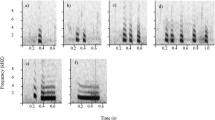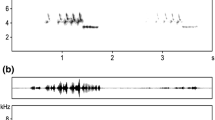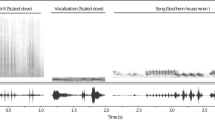Summary:
Bumblebees (Bombus terrestris) react to disturbances within the nest by a conspicuous hissing sound. The sound is characterised by a high intensity in the ultrasonic frequency range. It is elicited by vibrations of the nest and by mammalian breath and artificial air currents containing CO2. Domestic mice entering a bumblebee nest elicit these sounds and retreat immediately in response to the bumblebees' signal. It is concluded that the hissing sounds serve as aposematic warning signals aimed at predators entering the nest.
Similar content being viewed by others
Author information
Authors and Affiliations
Additional information
Received 27 February 1998; revised 15 September 1998; accepted 17 September 1998.
Rights and permissions
About this article
Cite this article
Kirchner, W., Röschard, J. Hissing in bumblebees: an interspecific defence signal. Insectes soc. 46, 239–243 (1999). https://doi.org/10.1007/s000400050140
Published:
Issue Date:
DOI: https://doi.org/10.1007/s000400050140




